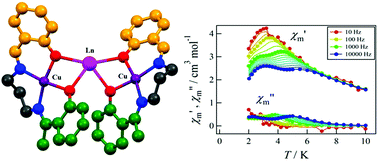当前位置:
X-MOL 学术
›
Dalton Trans.
›
论文详情
Our official English website, www.x-mol.net, welcomes your feedback! (Note: you will need to create a separate account there.)
Structural variations in (CuL)2Ln complexes of a series of lanthanide ions with a salen-type unsymmetrical Schiff base(H2L): Dy and Tb derivatives as potential single-molecule magnets
Dalton Transactions ( IF 4 ) Pub Date : 2017-08-10 00:00:00 , DOI: 10.1039/c7dt02061a Prithwish Mahapatra 1, 2, 3, 4, 5 , Soumavo Ghosh 1, 2, 3, 4, 5 , Naoki Koizumi 6, 7, 8, 9 , Takuya Kanetomo 1, 6, 7, 8, 9 , Takayuki Ishida 6, 7, 8, 9 , Michael G. B. Drew 10, 11, 12 , Ashutosh Ghosh 1, 2, 3, 4, 5
Dalton Transactions ( IF 4 ) Pub Date : 2017-08-10 00:00:00 , DOI: 10.1039/c7dt02061a Prithwish Mahapatra 1, 2, 3, 4, 5 , Soumavo Ghosh 1, 2, 3, 4, 5 , Naoki Koizumi 6, 7, 8, 9 , Takuya Kanetomo 1, 6, 7, 8, 9 , Takayuki Ishida 6, 7, 8, 9 , Michael G. B. Drew 10, 11, 12 , Ashutosh Ghosh 1, 2, 3, 4, 5
Affiliation

|
A new series of heterometallic trinuclear Cu2Ln complexes [lanthanide ions Ln = Gd (1), Tb (2), Dy (3), Ho (4) and Er (5)] has been synthesized using a Cu(II)-metalloligand derived from a N2O2 donor unsymmetrical Schiff base, H2L (where H2L = N-α-methylsalicylidene-N′-salicylidene-1,3-propanediamine), and structurally characterized. Among these complexes, [(CuL)2Gd(NO3)3(CH3CN)2] (1), [(CuL)2Tb(NO3)3(CH3CN)2] (2) and [(CuL)2Dy(NO3)3(CH3CN)2] (3) are isomorphic and isostructural. In these complexes two metalloligands coordinate to the central Ln(III) (Ln = Gd, Tb and Dy respectively) ion in a transoid fashion via μ2-phenoxido oxygen atoms. The Ln(III) ions are deca-coordinated with a distorted tetradecahedron geometry. The two terminal Cu(II) ions of the complexes possess a hexa-coordinated distorted octahedral geometry. In contrast, in complexes [(CuL)2Ho(NO3)3(CH3CN)], (4) and [(CuL)2Er(NO3)3(CH3CN)]·0.5(CH3CN) (5), the two metalloligands coordinated to the Ln(III) ions in a cisoid fashion. The Ho(III) ion in 4 is nona-coordinated with a distorted tricapped trigonal prismatic geometry and the Er(III) ion in 5 is octa-coordinated with a distorted square antiprismatic geometry. The two terminal Cu(II) ions in complexes 4 and 5 are penta-coordinated with a distorted square-pyramidal geometry. The dc magnetic susceptibilities and field dependent magnetization measurement of complex 1 reveal the occurrence of ferromagnetic interactions between Cu(II) and Gd(III) ions as well as intermolecular antiferromagnetic interactions. Both complexes 2 and 3 show ferromagnetic interactions between Cu(II) and Ln(III) ions. The ac magnetic susceptibilities of all the complexes were also recorded and it was found that only complexes 2 and 3 exhibit slow relaxation of magnetization reorientation below 10 K at 2000 Oe applied dc field, this being characteristic of single molecule magnets.
中文翻译:

一系列镧系离子与Salen型不对称席夫碱(H 2 L)的(CuL)2 Ln络合物的结构变化:Dy和Tb衍生物作为潜在的单分子磁体
使用Cu(II)-合成了一系列新的杂金属三核Cu 2 Ln配合物[镧系元素离子Ln = Gd(1),Tb(2),Dy(3),Ho(4)和Er(5)] 。衍生自N 2 O 2供体非对称席夫碱H 2 L(其中H 2 L = N - α-甲基水杨基-N'-水杨基-1,3-丙二胺)的金属配体,并在结构上进行表征。在这些络合物中,[(CuL)2 Gd(NO 3)3(CH 3 CN)2](1),[(CuL)2 Tb(NO 3)3(CH 3 CN)2 ](2)和[(CuL)2 Dy(NO 3)3(CH 3 CN)2 ](3)是同构的和同构。在这些配合物2个metalloligands坐标到Ln的中央(III)(Ln为钆,铽和Dy分别)离子在transoid方式经由μ 2个-phenoxido氧原子。Ln(III)离子以扭曲的十四面体几何形状进行十配位。二端子Cu(II)的离子具有六配位扭曲的八面体几何形状。相反,在络合物中[(CuL)2 Ho(NO 3)3(CH 3 CN)],(4)和[(CuL)2 Er(NO 3)3(CH 3 CN)]·0.5(CH 3 CN )(5),两个金属配体以cisoid方式与Ln(III)离子配位。何(III中)离子4是壬协调与扭曲三冠三角棱柱几何形状和铒(III)的离子5八角形与扭曲的方形反棱镜几何体协调。配合物4和5中的两个末端Cu(II)离子以扭曲的方锥几何结构进行五配位。配合物1的dc磁化率和与场有关的磁化强度测量表明,Cu(II)和Gd(III)离子之间发生铁磁相互作用以及分子间反铁磁相互作用。配合物2和3均显示Cu(II)和Ln(III)之间的铁磁相互作用)离子。还记录了所有配合物的交流磁化率,发现只有配合物2和3在2000 Oe施加的dc磁场下在10 K以下显示出磁化取向的缓慢弛豫,这是单分子磁体的特征。
更新日期:2017-09-20
中文翻译:

一系列镧系离子与Salen型不对称席夫碱(H 2 L)的(CuL)2 Ln络合物的结构变化:Dy和Tb衍生物作为潜在的单分子磁体
使用Cu(II)-合成了一系列新的杂金属三核Cu 2 Ln配合物[镧系元素离子Ln = Gd(1),Tb(2),Dy(3),Ho(4)和Er(5)] 。衍生自N 2 O 2供体非对称席夫碱H 2 L(其中H 2 L = N - α-甲基水杨基-N'-水杨基-1,3-丙二胺)的金属配体,并在结构上进行表征。在这些络合物中,[(CuL)2 Gd(NO 3)3(CH 3 CN)2](1),[(CuL)2 Tb(NO 3)3(CH 3 CN)2 ](2)和[(CuL)2 Dy(NO 3)3(CH 3 CN)2 ](3)是同构的和同构。在这些配合物2个metalloligands坐标到Ln的中央(III)(Ln为钆,铽和Dy分别)离子在transoid方式经由μ 2个-phenoxido氧原子。Ln(III)离子以扭曲的十四面体几何形状进行十配位。二端子Cu(II)的离子具有六配位扭曲的八面体几何形状。相反,在络合物中[(CuL)2 Ho(NO 3)3(CH 3 CN)],(4)和[(CuL)2 Er(NO 3)3(CH 3 CN)]·0.5(CH 3 CN )(5),两个金属配体以cisoid方式与Ln(III)离子配位。何(III中)离子4是壬协调与扭曲三冠三角棱柱几何形状和铒(III)的离子5八角形与扭曲的方形反棱镜几何体协调。配合物4和5中的两个末端Cu(II)离子以扭曲的方锥几何结构进行五配位。配合物1的dc磁化率和与场有关的磁化强度测量表明,Cu(II)和Gd(III)离子之间发生铁磁相互作用以及分子间反铁磁相互作用。配合物2和3均显示Cu(II)和Ln(III)之间的铁磁相互作用)离子。还记录了所有配合物的交流磁化率,发现只有配合物2和3在2000 Oe施加的dc磁场下在10 K以下显示出磁化取向的缓慢弛豫,这是单分子磁体的特征。


























 京公网安备 11010802027423号
京公网安备 11010802027423号